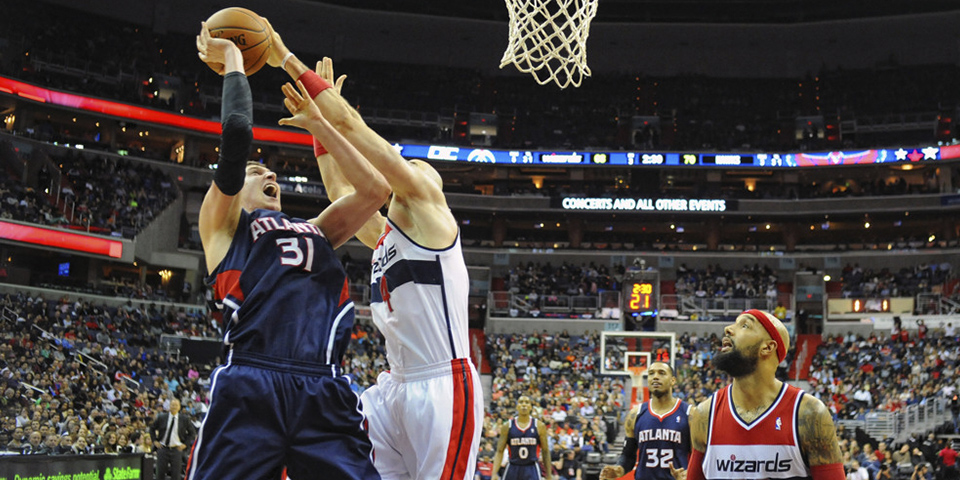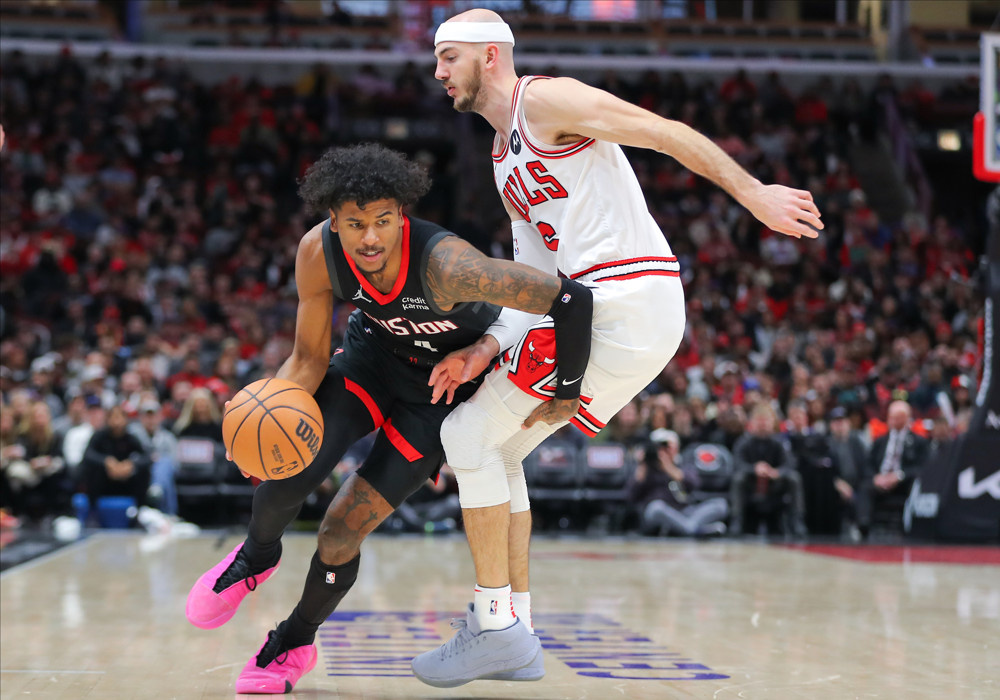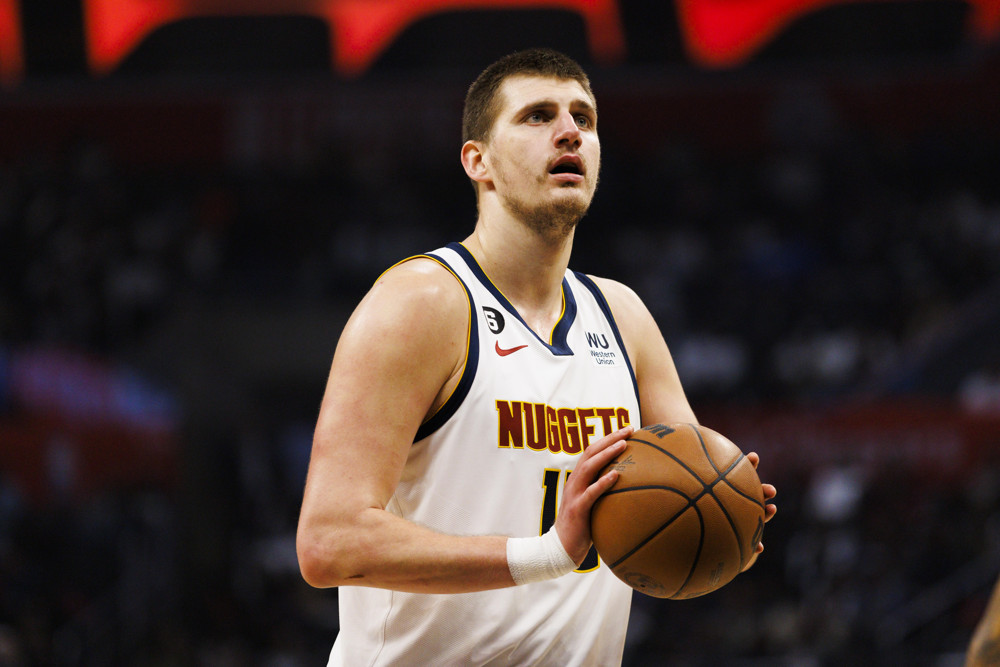Photo: Jevone Moore/Icon Sportswire
When Victor Wembanyama entered the NBA this past October, it was clear that with his unprecedented combination of size, mobility, and instincts, it was only a matter of time before he became one of the league’s premier defenders.
Few suspected that the timeframe in question would be measured in weeks, not years, including the Las Vegas betting lines, which gave him the 30th-best odds to win Defensive Player of the Year, just below Kelly Oubre. But as this season enters its final stretch, Wembanyama is widely considered to be the strongest challenger to Rudy Gobert’s push for his fourth Defensive Player of the Year award.
Rim Protector
His meteoric rise into the top echelon of NBA defenders starts with his absolute dominance protecting the rim. Despite playing on a minutes restriction for much of the season, Wembanyama leads the league in total blocks by a substantial margin, having collected 45 more than the 2nd-place Chet Holmgren.
It’s no surprise that Wemby puts a lid on the rim anytime he’s around it. Since the Spurs moved Zach Collins to the bench and Wembanyama to full-time center in early December, he has graded out in the 99th percentile for blocks around the rim and the 99th percentile in Contest Impact*.
*Contest Impact: The reduction of expected points caused by the quality of a player’s contest.
But one reason his block numbers are so high is that unlike more traditional big men, Wembanyama’s rejection radius extends far beyond the rim.
Wembanyama ranks in the 99th percentile for blocks and 87th percentile for defensive field goal percentage allowed on shots in the paint, and in the 95th percentile for total blocks against midrange shots this season.
Simply put: if a shot is going up anywhere past the three-point line, there’s no one in the league more likely to block it than Wemby.
Victor Wembanyama with the game-sealing BLOCK on Chet Holmgren ❌pic.twitter.com/jB8z3w5HDW
— ClutchPoints (@ClutchPoints) March 1, 2024
Disruptor
Where the rookie’s defensive maturation really pops is in the pick and roll. There’s a strong case to be made that Wembanyama has been the most complete pick and roll defender in the league this season, not just in terms of rim protection, where he ranks in the 99th percentile, but also as a disrupter.
According to SIS data, Wembanyama’s steal, deflection, and rim deterrence* as the screen defender in ball screen situations are all in the 98th percentile or higher, and what makes him unique for a big man is that his shot contest numbers are just as dominant when defending ball handlers.
*Rim Deterrence: An active scoring attempt by the opposing ball-handler is abandoned due to the defender’s presence.
To counter. Maybe Wemby can rely on the recovery. Good screen navigation, the defense feels like it's going to be fun. pic.twitter.com/u4Dl9bkI0f
— Steve Jones Jr. (@stevejones20) October 10, 2023
Wembanyama isn’t limited to simply being a dominant on-ball presence, though. He is also an elite help defender, already standing as one of the most effective weak-side rim protectors in the league, while showing impressive instincts and timing on rotations and playing passing lanes.
This is great help defense from Wemby, he stops Giddey's drive, rotates back to stop his initial man's baseline drive, stripes Joe when he spins back.
Wemby makes a nice behind the back dribble before throwing the lob that Wesley misses, lol pic.twitter.com/G2ZlleUpmV
— Mo Dakhil (@MoDakhil_NBA) October 10, 2023
For the season, take a look at his ranks
| Category | Percentile Rank |
| Steals | 87th |
| Deflections | 97th |
| Rim Deterrence | 99th |
These show that he’s not just a disruptor in ball screen situations, his length and timing, his very presence, changes the geometry of the floor. No pass or shot is safe around his 8-foot wingspan.
Webanyama vs Gobert
While his case is strong and growing stronger by the day, there are clear hurdles Wemby still has to overcome if he wants to take home the hardware: most notably, the chasm between his team’s defensive rating and Gobert’s Timberwolves, and the inherent conservatism of the award’s voters.
For the first point, while it’s true that the Spurs have been a lackluster defensive team this year on the whole, Wembanyama stands as far and away the person most responsible for them being below average rather than worst in the league.
This season the Spurs have a defensive rating of 122 and a 57% defensive field goal percentage with Wembanyama off the floor compared to 114 and 55% with him on.
Since the move to full-time center, the team’s defensive rating has gone from 22nd in the league to 18th, while the team’s defensive rating with him on the floor has improved even further, to 112.
While that is still a far cry from the Timberwolves’ league-leading 109 defensive rating, it does illustrate that there are few players, if any, who single-handedly swing their team’s defensive outlook the way Wembanyama does.
Tough for a young’un
As for the second obstacle mentioned, it’s no easy feat for a young player to make real noise in the Defensive Player of the Year conversation.
No one younger than 23 has ever won DPoY in the NBA. In fact, since 2000, the only players 21 or younger to even crack the top five of voting are Kobe Bryant (2000), Anthony Davis (2014 and 2015), Jarrett Allen (2019), and Evan Mobley (2023).
Alvin Robertson (1985) is the only 2nd-year player to ever win the award, and Leonard is the only player since 1992 to win in the 4th year of his career or earlier. The defining defenders of this generation (Dwight Howard, Draymond Green, Rudy Gobert) all won in year five. Joel Embiid was second in voting as a 2nd-year player, but he was already 23 and 4 years past his draft date at the time.
There’s a good reason for this.
NBA defense is very difficult, and even the best defenders need time to learn, refine, and start dominating. Similarly, quantifying defensive impact can be difficult, requiring synthesis of multiple individual and team metrics, plus a heavy dose of the eye test, to approach anything like a well-rounded conclusion, which lends itself to voters wanting a large sample size before making declarations on young players.
There are many barriers to a rookie winning – or even being runner-up for – the coveted award, but if there was ever a player capable of beating out those odds, it’s Wembanyama.



